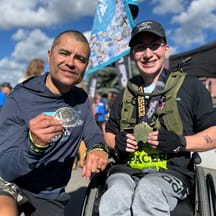A 17-year-old patient was brought to the emergency department due to increasingly aggressive behavior at school. Although she arrived calm, she paced around the unit and appeared to become more upset. Unsure of how to intervene, health care providers encouraged the patient to stay in her room. Soon after, the patient started yelling, using expletives and attempting to hit and spit on staff. Security was called to the room to assist in keeping the patient and staff safe, which resulted in the use of restraints.
This familiar scenario occurs frequently in pediatric emergency departments in hospitals across the country. Trends have shown a significant increase in the number of pediatric behavioral health emergencies. Many of these patients exhibit other adverse behaviors in addition to aggression.
Behavioral health patients who present with a chief complaint of aggression are particularly challenging, and each month can represent roughly 10% to 20% of pediatric emergency department visits at Monroe Carell Jr. Children’s Hospital at Vanderbilt in Nashville, Tennessee.
Minimizing disruptive behavior
As the hospital experienced an increase in the number of patients demonstrating aggressive behaviors, staff recognized a need to improve their ability to provide a safe and effective environment to meet these patients’ health care needs. To do so, the hospital formed a multidisciplinary workgroup to improve and standardize the care of patients demonstrating aggressive behaviors, with a focus on improving safety for patients and hospital staff.
The goal of the workgroup was to develop a common language that health care teams could use with patients who have behavioral health care needs. Some members of the group were familiar with a scoring system that could identify acute aggressive episodes and help predict the escalation of aggressive behaviors, allowing health care providers to intervene earlier in the episode.
Ultimately, the group chose to leverage the Broset Violence Checklist (BVC). Developed in Norway, the BVC helps health care providers measure aggression and predict violence. Because it had been used predominately in behavioral health facilities, the group adapted the BVC for use in the pediatric emergency department.
In addition, the team developed both pharmacological and nonpharmacological interventions based on patient scores from the BVC. They knew that adopting the use of the BVC and the associated interventions would require collaboration and buy-in from caregivers from all disciplines, as well as education and training.
How to score and treat patient aggression
The multidisciplinary workgroup included child and adolescent psychiatrists, nurses and pediatric emergency medicine physicians. Together, they adapted the BVC’s key concepts that assess six behaviors and score a patient’s risk for becoming violent from small to severe.
They implemented interventions to meet the needs of patients with aggression in a non-psychiatric setting, and they developed an ordered set of medications that correspond with BVC scores. The team was able to optimize the physician ordering panel in the electronic medical record to make it easier to order these medications, reducing delays in medication administration.
The scoring tool and medications were important aspects to changing the care provided to patients with aggression, but they were not the only changes needed. The group found that including nonpharmacological interventions tailored to individual needs provided the most benefit for treating aggression or preventing aggressive behaviors.
Including tailored nonpharmacological interventions provided the most benefit for treating aggression.
With the expertise of nurses, social workers, and child life teams, they developed nonmedical interventions that health care providers could implement upon a patient’s arrival to the emergency department, when possible. Some of the most successful of these interventions are the My Health Passport and Safe Activity Bags.
My Health Passport is a tool that the patient, family or clinical staff completes to identify optimal verbal and nonverbal actions that create a positive environment for the patient and family. This tool allows the patient and family to share with the health care team what works well for them when the patient is in crisis.
The patient and family can use the passport to identify specific triggers for agitation or aggression and tactics that can help prevent or deescalate them. Taking the time at the beginning of the visit to complete this tool is paramount to creating an atmosphere that is familiar to the patient while in the stressful and unfamiliar emergency department environment.
The team also discovered that safe activities for these patients are difficult to identify and locate in the emergency department. That is why they developed Safe Activity Bags, which used along with the BVC, ensure caregivers have safe activities readily available that meet the developmental level of the patient. Explaining the importance of these tools to family members to gain their understanding and partnership is optimal for success.
Provider education and training
Before implementing the new scoring tool and interventions, the workgroup chose a different approach to education and training for their teams. They decided to pilot the tool with a small group of nurses to allow them to adjust and change as needed before making the tools and interventions widely available.
Participating nurses had self-identified as having an interest in caring for pediatric behavioral health patients in the emergency department setting. These nurses would also serve as early adopters of the change in practices.
This approach proved to be successful, and the workgroup made changes based on the nurses’ feedback, which improved the overall care of patients. The group then added more nurses to the pilot. This team of nurses developed into the group’s champions once they implemented the BVC, interventions and medication order sets for all patients who presented to the emergency department with aggression.
Improved behavioral health care
Since implementing the BVC, data indicate the consistent use of the checklist with the hospital’s aggressive patient population has improved the overall care and safety of these patients. The use of score-based interventions has resulted in a 50% decrease in the use of restraints compared to baseline data.
In addition, the overall response from caregivers has been positive, reflecting improvement in their ability to provide effective, standardized care while keeping the needs of each patient in the plan of care.
The hospital also has seen a shift in team culture, with a greater understanding of the needs of patients and how caregivers must adapt the hospital environment in ways that meet each patient’s needs. The health care providers at Monroe Carell Jr. Children’s Hospital at Vanderbilt continue to create an environment that supports patients who present with behavioral health emergencies.
The workgroup learned the importance of training caregivers who have different levels of education, knowledge and comfort levels in providing behavioral health care. The most important lesson learned is that each learner is different, and education must be paired with coaching—sometimes individualized coaching—to achieve understanding and the application of new knowledge into nursing care.
Medication management is just one component of this, and without the full complement of nonpharmacological interventions, success will be limited.
This group also learned that involving patients and families was crucial for this work to succeed. Patients and their families needed to understand and be part of the use of the different tools and interventions. The incorporation of My Health Passport and having a common understanding of how best to communicate and interact with each patient created a positive and collaborative environment.



